Protein separations via thermally responsive ionic block copolymer brush layers†
Abstract
Temperature-responsive (thermoresponsive) protein adsorption on a block copolymer brush layer is demonstrated. Specifically, silica beads were modified with poly(3-acrylamidopropyl trimethylammonium chloride)-b-poly(N-isopropylacrylamide) (PAPTAC-b-PIPAAm) via multi-step atom-transfer radical polymerization. The beads were characterized with X-ray photoelectron spectroscopy, carbon/hydrogen/nitrogen elemental analysis, and gel-permeation chromatography. When they were used as chromatographic packing materials, an analysis of adenosine nucleotides indicated that the ionic properties of the copolymer brush layer could be modulated by the length of the PAPTAC segment. In addition, the elution of milk serum indicated that the proteins α-lactalbumin and β-lactoglobulin adsorbed on the copolymer brush layer at high temperature; they desorbed when the temperature was reduced. Thus, separation of milk serum proteins can be performed by simply changing the column temperature. In general, the block copolymer brush-modified beads could be used as thermally responsive chromatographic matrices for protein separations.


 Please wait while we load your content...
Please wait while we load your content...